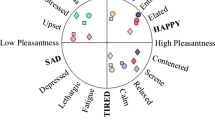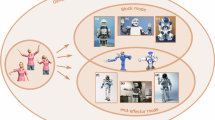Abstract
Our goal is to develop bodily mood expression that can be used during the execution of functional behaviors for humanoid social robots. Our model generates such expression by stylizing behaviors through modulating behavior parameters within functional bounds. We have applied this approach to two behaviors, waving and pointing, and obtained parameter settings corresponding to different moods and interrelations between parameters from a design experiment. This paper reports an evaluation of the parameter settings in a recognition experiment under three conditions: modulating all parameters, only important parameters, and only unimportant parameters. The results show that valence and arousal can be well recognized when the important parameters were modulated. Modulating only the unimportant parameters is promising to express weak moods. Speed parameters, repetition, and head-up-down were found to correlate with arousal, while speed parameters may correlate more with valence than arousal when they are slow.
Access this chapter
Tax calculation will be finalised at checkout
Purchases are for personal use only
Preview
Unable to display preview. Download preview PDF.
Similar content being viewed by others
References
Breazeal, C., Takanishi, A., Kobayashi, T.: Social robots that interact with people. In: Springer Handbook of Robotics, pp. 1349–1369. Springer, Berlin (2008)
Zecca, M., Mizoguchi, Y., Endo, K., Iida, F., Kawabata, Y., Endo, N., Itoh, K., Takanishi, A.: Whole body emotion expressions for kobian humanoid robot - preliminary experiments with different emotional patterns. In: RO-MAN, pp. 381–386. IEEE (2009)
Hirth, J., Schmitz, N., Berns, K.: Towards social robots: Designing an emotion-based architecture. Int. J. Social Robotics 3, 273–290 (2011)
Häring, M., Bee, N., Andre, E.: Creation and evaluation of emotion expression with body movement, sound and eye color for humanoid robots. In: RO-MAN, pp. 204–209. IEEE (August 2011)
Beck, A., Stevens, B., Bard, K.A., Cañamero, L.: Emotional body language displayed by artificial agents. ACM Trans. Interact. Intell. Syst. 2(1), 1–29 (2012)
Xu, J., Broekens, J., Hindriks, K., Neerincx, M.A.: Mood Expression through Parameterized Functional Behavior of Robots. In: ROMAN, Gyeongju, Republic of Korea (in press, 2013)
Xu, J., Broekens, J., Hindriks, K., Neerincx, M.A.: The Relative Importance and Interrelations between Behavior Parameters for Robots’ Mood Expression. In: ACII, Geneva, Switzerland (in press, 2013)
Wallbott, H.: Bodily expression of emotion. European J. Social Psychology 28(6), 879–896 (1998)
Pelachaud, C.: Studies on gesture expressivity for a virtual agent. Speech Communication 51(7), 630–639 (2009)
von Laban, R., Ullmann, L.: The Mastery of Movement, 4th edn. Dance Books, Limited (2011)
Chi, D., Costa, M., Zhao, L., Badler, N.: The emote model for effort and shape. In: SIGGRAPH, pp. 173–182. ACM (2000)
Engeldrum, P.G.: Psychometric scaling: a toolkit for imaging systems development. Imcotek Press (2000)
Rajae-Joordens, R., Engel, J.: Paired comparisons in visual perception studies using small sample sizes. Displays (2005)
Russell, J.A.: A circumplex model of affect. Journal of Personality and Social Psychology 39, 1161–1178 (1980)
Bergmann, K., Kopp, S., Eyssel, F.: Individualized gesturing outperforms average gesturing – evaluating gesture production in virtual humans. In: Safonova, A. (ed.) IVA 2010. LNCS, vol. 6356, pp. 104–117. Springer, Heidelberg (2010)
Lang, P.J., Bradley, M.M., Cuthbert, B.N.: International Affective Picture System (IAPS): Technical Manual and Affective Ratings (1997)
Author information
Authors and Affiliations
Editor information
Editors and Affiliations
Rights and permissions
Copyright information
© 2013 Springer-Verlag Berlin Heidelberg
About this paper
Cite this paper
Xu, J., Broekens, J., Hindriks, K., Neerincx, M.A. (2013). Bodily Mood Expression: Recognize Moods from Functional Behaviors of Humanoid Robots. In: Herrmann, G., Pearson, M.J., Lenz, A., Bremner, P., Spiers, A., Leonards, U. (eds) Social Robotics. ICSR 2013. Lecture Notes in Computer Science(), vol 8239. Springer, Cham. https://doi.org/10.1007/978-3-319-02675-6_51
Download citation
DOI: https://doi.org/10.1007/978-3-319-02675-6_51
Publisher Name: Springer, Cham
Print ISBN: 978-3-319-02674-9
Online ISBN: 978-3-319-02675-6
eBook Packages: Computer ScienceComputer Science (R0)




